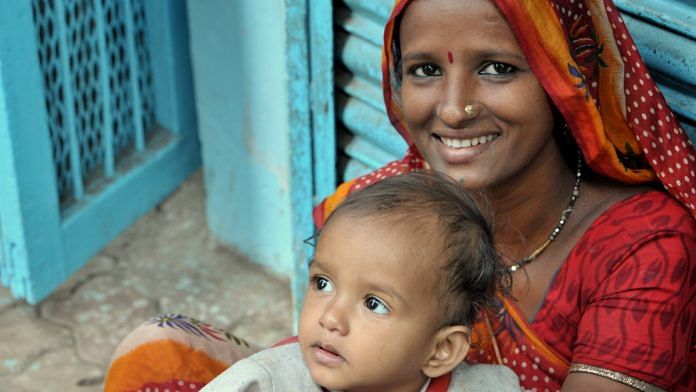Srinivaspuri is a large urban slum located in southern Delhi close to busy highways and office blocks. It’s difficult to say how many people live there because large portions of the Delhi population are clustered in unauthorized communities. The residents, who are largely migrants from neighboring, rural states, come and go every day. Let’s just say that based on what we saw, it’s a lot of people. Communities like Srinivaspuri are the leading edge for fertility change in India. These rural emigrés are discovering for the first time that children are expensive, now that they can no longer contribute to the family’s labor pool as they did on the farm. Many of the women are being exposed for the first time in their lives to education, employment, and modern technology. So what impact are these forces, which have reduced birth rates around the world, having on Srinivaspuri?
The slum is a jumble of makeshift buildings constructed with rough bricks and recycled building materials. These one-room hovels are artfully jammed into wherever it’s possible to build a wall. The only features that define their placement are the footpaths of broken concrete that snake through the community. Most of the buildings have curtains across the front that are either open or partially drawn. A few have doors. Inside are single rooms with large carpets covering their earthen or concrete floors. All of life happens in that one room—cooking, sleeping, and the rest of what we do as human beings. Pots and pans and other kitchen items and groceries are either stacked on the floor or hang from the walls.
The narrow walkways are interrupted by random ladders—some homemade, some prefab—that ascend to additional units built on top of the buildings at street level. Laundry hangs colorfully everywhere. Most units appear to have some form of electricity, but the seemingly random wires that snake in all directions wouldn’t pass any safety code. Along both sides of the walkway are single, uniform, shallow trenches, each about a foot wide. These are open sewers. As for toilet facilities, we didn’t see any. But, the smells in the air suggest that whatever was being used could best be described as primitive.
It’s about ten on a pleasantly mild Friday morning in March, and Srinivaspuri is a very busy place. The walkways are teeming with people, young and old. The women are dressed in brightly colored saris, their long, dark hair covered with a scarf or tightly pulled back. The men wear Western clothes—logoed T-shirts and shorts or trousers. As for footwear, both genders wear sandals. Everyone is expected to take off their shoes before entering a home. Given what we are walking through, that seems like a very good idea.
Our destination is a preschool located thirteen minutes from the slum entrance. Our local colleagues have organized two focus groups for us with women living in the slum. A total of fifteen women have agreed to participate. They are both married and single; the oldest is thirty-five years of age, the youngest is seventeen. Four are Muslim, the rest are Hindu. We spoke to the married and unmarried women separately. The discussions were in Hindi, with the colleague who moderated the groups repeating what was said in English.
Also read: ISRO’s women scientists who busted ‘Mars is for men’ and other such myths with MOM
As in the residences, a single large mat covers the earthen floor of the tiny, one-room school. The walls are adorned with tattered alphabet posters, as well as charts of shapes, colors, and animals. One of the alphabet posters is in English. We remove our shoes and enter the room. Everyone sits on the mat. There is no door or curtain to close, just a raised cement threshold to step over. The room is open to the street.
One of the women who joins us breast-feeds a baby under her shawl. The women are all dressed in brightly colored saris, and adorned with assorted jewelery, including bangles, finger and toe rings, and nose jewelery. Some also have painted nails and henna tattoos. These women spend considerable time attending to their appearance.
But they are shy in conversation, and we are discussing a sensitive subject in a public forum. After some introductory “getting to know you” chatter, our moderator gets down to business. “How many kids do you plan to have?” she asks. For those who haven’t started a family yet, or for those with only one child, the answer is universal: “two.” Our moderator asks why, and things start to get interesting. The younger women say that they want to live different lives than their mothers, whom they regard as cautionary tales. They want to have fewer kids because they aspire to having the independence that would come from a good education and the earning potential that it brings. Having their own source of income would give them leverage, they believe, in negotiating with men, including their husbands, over the big issues in their lives.
The other reason for having two children is the desire to create a “complete family.” It seems the “We Two, Our Two” norm is hitting home. As several women tell us, they wouldn’t want to have just one child. That’s because family responsibilities (especially the care of elderly parents) in Indian families are considerable, and it would be too much of a burden for one child. But more than two children would be an unaffordable expense (although one woman said she had five children and was making do). To quote one participant, “Doing what needs to be done to raise two children seems all that’s possible, given the expense of raising and educating children.”
While the women want complete families, they are also quick to remind us that it isn’t their decision to make. As one participant tells us, “The husband decides on the number of kids, not the mother.” “It’s all about having a boy,” one mother explains. “I had three daughters but had to keep going until I had a boy.” The one woman in the married group who has five children says that this was the result of having daughters to start.
One subject the women are reluctant to discuss is birth control. It is clear, though, that for them, the more certain the solution (i.e., sterilization), especially after two children, the better, since their men won’t consider using condoms or getting sterilized themselves. For the Muslim women, sterilization was not an option for religious reasons.
There is little talk of romance in the room, no longing among the single women for ideal mates and fairy-tale weddings—ironic, given the idealized romances featured in popular Bollywood movies. These women do not hold their husbands in high regard. Their men are unreliable providers and hard to live with. Most are day laborers who only work when they feel like it and spend too much of the proceeds on alcohol and gambling. Drinking is repeatedly raised as a big issue in their marriages.
For all, marriage and children are responsibilities, not aspirations. And yet, though they want to be wives and mothers, they also dream of doing as much as possible on their own terms. A thought occurs: as these young women pass their aspirations for independence on to their daughters, that demand for greater autonomy is likely to grow—slowly but inexorably, generation by generation. In the slums of Delhi, family planning involves economic need, clashing traditions, the power of religion and the patriarchy, the aspirations of women to have control over their lives. This can only lead to greater independence and fewer children. The struggle for the rights of women goes only in one direction.
A surreptitious proof of how that struggle will end reveals itself as we talk. From time to time, the women reach under their robes and glance at a backlit screen. Even in the slums of Delhi, women can access a smartphone, a carrier plan, and a network. Even in the slums of Delhi, they hold the sum of human knowledge in their hands.
Also read: The MBA who is helping Indian women breastfeed
Will India’s population, as the UN predicts, peak at 1.7 billion in 2060? On this, at least, Wolfgang Lutz and his colleagues at the International Institute for Applied Systems Analysis basically agree. But over and over again during our stay in Delhi, demographers and government officials conducting local research told us, sotto voce, that they suspected the fertility rate had already dropped below 2.1. If so, then India is a decade ahead of where both the UN and the Vienna school have it. If India is already at or below 2.1, then it is unlikely to reach much past 1.5 billion, according to the low-variant models, and will be back down to 1.2 billion by 2100.
If the UN modelers are right, China and India could help the world reach something close to eleven billion. But China and India are sending strong signals that those predictions are too high, that both countries will peak in population sooner than many expect, and then join most of the rest of the planet in shedding population.
Of course, we could be wrong, but we don’t think so. We keep thinking of those women in that school in a Delhi slum, checking their smartphones beneath their robes.
 Excerpted with permission of Hachette India from Empty Planet: The Shock of Global Population Decline by Darrell Bricker and John Ibbitson. Paperback Rs. 599
Excerpted with permission of Hachette India from Empty Planet: The Shock of Global Population Decline by Darrell Bricker and John Ibbitson. Paperback Rs. 599






